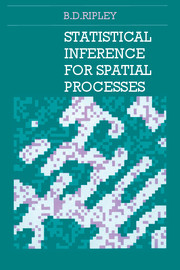Preface
Published online by Cambridge University Press: 05 June 2012
Summary
The statistical study of spatial patterns and processes has during the last few years provided a series of challenging problems for theories of statistical inference. Those challenges are the subject of this essay. As befits an essay, the results presented here are not in definitive form; indeed, many of the contributions raise as many questions as they answer. The essay is intended both for specialists in spatial statistics, who will discover much that has been achieved since the author's book (Spatial Statistics, Wiley, 1981), and for theoretical statisticians with an eye for problems arising in statistical practice.
This essay arose from the Adams Prize competition of the University of Cambridge, whose subject for 1985/6 was ‘Spatial and Geometrical Aspects of Probability and Statistics’. (It differs only slightly from the version which was awarded that prize.) The introductory chapter answers the question ‘what's so special about spatial statistics?’ The next three chapters elaborate on this by providing examples of new difficulties with likelihood inference in spatial Gaussian processes, the dominance of edge effects for the estimation of interaction in point processes. We show by example how Monte Carlo methods can make likelihood methods feasible in problems traditionally thought intractable.
The last two chapters deal with digital images. Here the problems are principally ones of scale dealing with up to a quarter of a million data points. Chapter 5 takes a very general Bayesian viewpoint and shows the importance of spatial models to encapsulate prior information about images.
- Type
- Chapter
- Information
- Statistical Inference for Spatial Processes , pp. vii - viiiPublisher: Cambridge University PressPrint publication year: 1988

